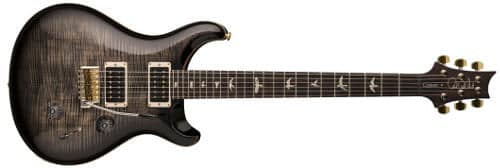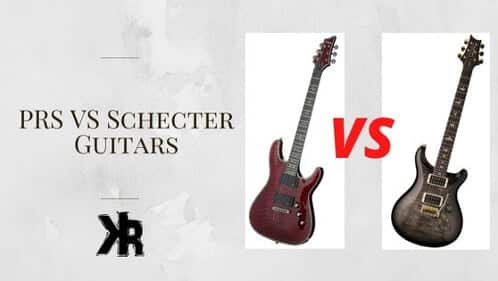Table of Contents
Maybe you’re a beginner looking to pick up an affordable instrument. Or an experienced player who wants to make their next purchase stand apart from the rest! PRS and Schecter guitars will be appealing choices.
Both companies offer great value for the money. They have made a name for themselves by introducing their excellent guitar models.
Schecter is better for metal because of their slim necks, sleek bodies, and high output pickups. PRS is more of a traditional guitar suited for a wider range of music styles. This includes rock, blues, and even metal.
Which comes out on top? How do they compare? This Killer Rig article will help you narrow down your search. Especially when it comes to finding out which is better between PRS Vs Schecter guitars.
Quick Summary
When comparing PRS and Schecter guitars, there are a few factors to consider. Here are some points to keep in mind:
PRS Guitars:
- PRS guitars are more traditional and versatile.
- They are generally made in the USA.
- They have a reputation for high quality.
Schecter Guitars:
- Schecter guitars are known for their slim necks, sleek bodies, and high output pickups, making them well-suited for metal.
- They are generally made in Korea.
- They are often considered a good value for the price.
History of PRS and Schecter Guitars
PRS and Schecter have a long history of making guitars. Both have been synonymous with quality. Let’s start with the backstory of these two brands.
PRS Guitars

PRS was founded in 1985 by Paul Reed Smith, a master luthier. In the 70s and 80s, Paul Reed Smith sold guitars by taking them personally to live concerts backstage. Just so performers could try them.
With this strategy, many well-known professional musicians began to know and endorse his guitars. This included Ted Nugent, Peter Frampton, Al Di Meola, and Carlos Santana.
In 1994, Ted McCarty, former president of Gibson, got in touch with Smith. The two worked together to create solid and hollow-body guitars.
The ones that make up the current PRS brand. For the private stock of PRS guitars, you will find many materials. A wide variety of varied stones, carved tonewoods, and exquisite shells for inlays.
The company has grown into one of the world’s largest manufacturers of guitars and basses. Its main goal is to produce unique and high-quality instruments. All while keeping prices affordable for all musicians.
PRS added their S2 Series in 2013. In February 2018, the company started making a Silver Sky model. This was based on John Mayer’s favorite guitars from the ’60s.
In 2019, PRS launched three SE signature models. These were the Santana Single cut Tremolo, Paul’s Guitar, and Schizoid.
Schecter Guitars

David Schecter opened Schecter Guitar Research in 1976. It was a repair shop based in Van Nuys, California. The business mainly produced guitar parts only.
Schecter’s work became so famous that many guitarists pushed him to produce instruments. And all from scratch!
Schecter launched his first fully assembled guitar in 1979. It was heavily inspired by Fender designs. The first Schecter guitars were considered high-end and expensive. Sold only by around twenty retailers across the country.
In 1983, a group of Texas investors purchased the company. They began launching numerous guitars and basses the year after. The most famous model from this product line was a Telecaster-style guitar. It was similar to the ones Pete Townshend used.
Since then, Schecter continues to be known as one of the best guitar companies in the world. Today, the company offers an extensive product line. This consists of guitars, acoustics, basses, and Custom Shop instruments worldwide.
Many famous guitarists have used Schecter models. This includes, and is not limited to:
- Mark Knopfler
- Chris Poland
- Ritchie Blackmore
- Richard Patrick
- Synyster Gates
- Shaun Morgan
- Robin Zander
Check out our Ibanez vs Schecter comparison here!
Differences Between PRS vs Schecter Guitars
What are the main differences between PRS and Schecter guitars? This section compares both brands. Specifically regarding sound quality, build, looks, playability, and music style.
Sound Quality
Schecter’s humbucker pickups are usually made for metal and modern rock tones. These high-quality pickups include the Brimstone and Apocalypse sets. Their San Andreas pickup is also of good quality, providing the tone with a mid-range boost.
Schecter also has EMG pickups on some of their guitars, such as the Hellraiser model. This guitar is designed specifically for saturated metal distortion. But regardless, their pickups will always shine because of their tonal characteristics.
On the other hand, PRS core model guitars have their pickups hand-wound. This is done by a group of talented professionals in their Maryland plant.
Paul Reed Smith also carefully selects each pickup part. Things like wire and bobbins. Since he demands nothing less than the best for his guitars.
PRS makes a wide variety of pickups, so musicians can find the tone they’re looking for. PRS guitars can offer a wide range of tones depending on the model and modifications.
In that case, since so many of them sound different, it is challenging to identify the PRS signature tone.
Build Quality
With each new release, Schecter continuously raises the standard. Given the price point, the new models they are releasing are incredible.
Additionally, they are using their custom shop pickups. Which some players believe to be the best pickups that come in a huge range of tones and styles.
Over the past few years, Schecter has significantly improved their quality. This is done with their hardware, electronics, and wood selection. In short, Schecter guitars are well-built.
Additionally, PRS guitar build quality is unquestionably good. With their highly specialized glues and materials and drying procedures.
PRS does pour a little more passion into their models. Rarely will a PRS guitar require modifications to play it at its best right out of the box. This is due to PRS’s top-notch quality control.
Check out our Fender vs PRS comparison before you go!
Looks and Aesthetics
For looks, you can’t go wrong with either PRS or Schecter. This category will pretty much come down to your preferences.
As for Schecter, some players don’t like their flashy-looking guitar models. However, they do have the Sun Valley models that feature a more classic look.
As for PRS, they have their signature series. It features a lot of wood inlays and other details that are not common on their other models. The SE line has a few options for those who want something different from their usual style. But still want to stick with the company.
PRS has a more classic look to their guitars, which is probably what most people think of when it comes to the brand.
Feel
The feel of a guitar is important because it can greatly affect the player’s performance. If the guitar is uncomfortable to play, it might make it harder for the guitarist to find their groove. It’s then harder to perform at their best.
In terms of playability, Schecter guitars can be much more comfortable to play! This is because they have larger fret wires and thin necks. The scale length of most Schecter guitars, which is 25.5 inches, is also longer than PRS, measuring 25 inches.
However, all these details still depend on the player’s preferences. For example, if you prefer large fret wires and longer scales, you may want to go with a Schecter instead of a PRS model.
Whichever you choose, you will find that each brand makes very comfortable and easy-to-play guitars for all styles.
Check out the Ibanez vs PRS comparison we did here!
Music Style
Both companies provide a variety of models that can accommodate most musical styles. Yet, Schecter has found a market niche in the metal scene. This does not imply that their guitars can only play metal.
Schecter is focusing all their marketing efforts in that way. Designing their guitars to best match that musical genre. Schecters are essentially seen as metal guitars that shredders frequently choose.
Hard rock and blues sound amazing on PRS guitars. PRS is also better suited for the country genre.
This is because of its endorsees and their respective signature models. Yet, the PRS guitar is also incredibly versatile! So you could easily play metal and many other musical styles.
Price Range
Schecter’s guitars are just as good as PRS, but some Schecter models are more affordable. If you’re on a budget, PRS and Schecter offer incredible guitars for under $1,000.
If you’re looking for a guitar that’s both reliable and affordable, check out the PRS SE Standard 24 at $499. This model is suitable for beginners or intermediate players. It offers a warm tone with excellent volume.
Looking for something more versatile? Consider the Schecter Omen Extreme 6 at $499. The Schecter Omen Extreme 6 is designed for more experienced players. Time spent with other guitars who know what they want in terms of features and design.
Here are a few other Schecter and PRS guitars and their prices that are worth considering.
| Guitar Model | Price |
|---|---|
| Schecter Reaper 6 FR-S | $1199.00 |
| PRS Paul’s Guitar | $1029.00 |
| Schecter Solo-II | $1299.00 |
| PRS CE 24 | $2499.00 |
Conclusion
Ultimately, the choice will come down to preference. PRS and Schecter guitars can even be identical in looks. Though, they have specific characteristics of sound and feel.
Between PRS and Schecter guitars, it’s likely that you can’t go wrong with either choice. Both brands produce stylish instruments that offer a lot of flexibility. Both in terms of sound and playability.
The best approach is to visit a music store and test out a few models. Then decide which one sounds and feels the way you want it to.

